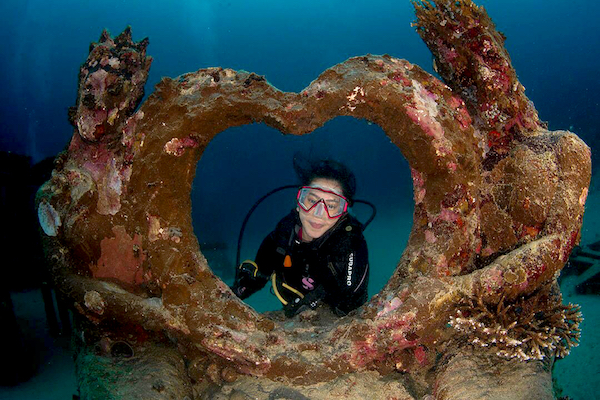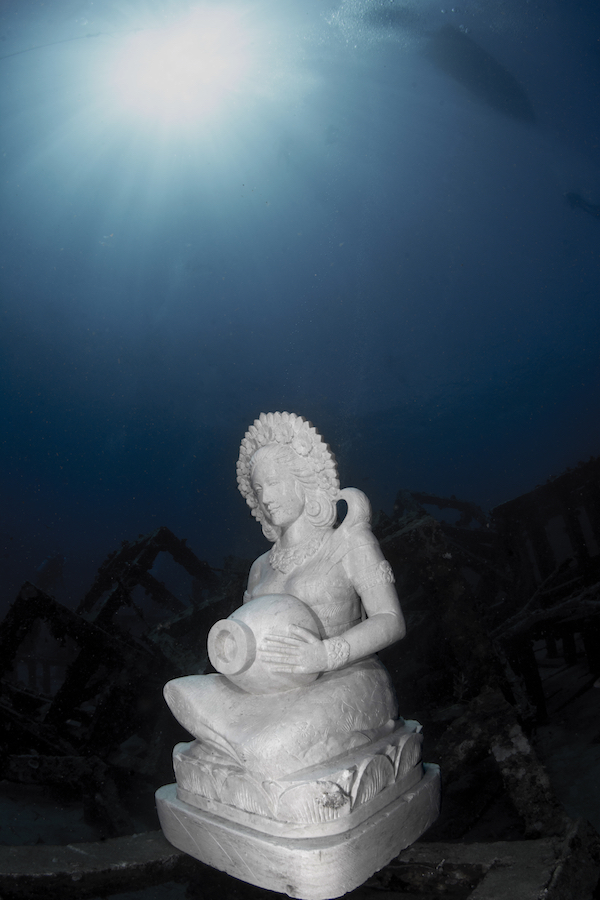Art has a purpose in conservation and the coral garden is an extension of this, discovers Mallika Naguran.
MANADO, 27 August 2019. Somewhere in the Bunaken Sea, you’d be forgiven if you said you bumped into a mermaid.
The Love Mermaid by Marine Foundation sunk in 2016 drew a number of scuba divers and free divers. Courtesy: Toar Pantouw
Fairy tales aside, mermaids and other beautiful objects are being sculpted and placed beneath the sea as I write. This artistic project by Luley Dive Centre in Manado, Indonesia, is a way of capturing the beauty of the wild while stimulating a new marine garden full of corals and other sea creatures.
Its artist Celia Gregory of Marine Foundation is all too familiar with the mission of transforming the underwater terrain as she first sank the Love Mermaid in 2016. Instagrammers still visit the site to pose through the heart shaped gap between King & Queen, now looking somewhat ghoulish while encrusted with hard corals.
The site has since expanded into what is hoped to be a fuller coral garden by the end of 2019 with dolphins, fish and other female carvings made out of volcanic rock. In years to come these manmade objects may lend a surreal feel to underwater scenes, but they’ll be a functional habitat to live creatures.
But why sculptures?
Art as a Persuasive Device
There’s a reason for letting art flood the imagination in marine conservation.
Years later, the Love Mermaid still draws marine enthusiasts as well as coral and fish. Courtesy: Toar Pantouw
A creative approach is a powerful way to engage people in sustainable solutions to environmental issues, believes Gregory. “We believe scientific information alone is unable to persuade a good many people, especially children of the reality and complexity of the environmental issues we face… This is where the creative approach can make a difference.”
“The arts do not show people what to do, yet engaging with a good work of art or story can connect you to your senses, body, and mind. It can make the world felt,” says Gregory.
The idea of having such a coral garden with sculptures near Bunaken Marine Park came about when Suzy Hutomo, the owner of Grand Luley Manado resort, met Gregory some years ago. “From our conversation, I then came to know about underwater sculptures and how art can be used to inspire one to protect the environment,” says Hutomo.
She then knew how she could help the Bunaken Sea and save it from the numerous threats, particularly coral stress due to excessive snorkeling or diving in popular sites. She then engaged Marine Foundation in a creative collaboration with Luley Dive Centre to create an underwater artistic garden in Manado, North Sulawesi. This has become the hotels’ house reef, just a five-minute boat ride from the hotel’s jetty, at a depth of 10 to 18 metres.
The sinking of the Lady with a Bowl sculpture is no easy feat, and is led by the commissioner Luley Dive Centre in Manado. Courtesy: Toar Pantouw
Hutomo is hopeful that with the addition of new statues, it would stoke further the interest of marine enthusiasts. The sculptures will complement an artificial reef already in place with the help of the Coral Triangle Center, Luley Dive Centre and the Bunaken Marine Protected Area (MPA) officials.
Concrete tables on which staghorn corals are being transplanted are part of a coral nursery in the making. These gradually and inevitably attract fish and other marine critters, thus bringing a vibrant sea life where there was little or none before.
To Hutomo, who runs the Body Shop chain in Indonesia as sustainably as possible, the coral garden is just a creative way of conserving natural resources. The mother of three is also popularly known as Sustainable Suzy on social media. No wonder.
Stakeholder Support in Marine Conservation
The Lady with a Bowl inspires conservation through art. Courtesy: Toar Pantouw
On 26 June 2019, the ‘Lady with Bowl’ was sunk in Bunaken to great fanfare. “This sculpture symbolises hope and commitment to preserving our oceans well-being for all future generations. The sculptures provide habitat for coral and marine life to settle and grow on,” says Gregory.
On that day, two other programmes were launched: adopt a baby coral and sponsor a baby mangrove. These conservation projects have received enthusiastic support from the local community. Altogether, the investment in these projects, event and awareness communications amount to USD30,000.
Hutomo tells me that involving stakeholders is of prime importance in establishing any conservation programme. “We need the villagers and the leaders to understand the ocean better,” says Hutomo, adding that local schools, dive centres, media and Mayor were made aware of the project along with the authorities such as the Department of Environment of Bunaken and the Department of Forestry and Conservation from Jakarta.
Hutomo stresses that it is only with experience at sea (through snorkeling, for instance) and knowledge of corals that will enable children and adults to understand the need to protect the marine environment.
“The best thing is education,” she says, adding that educating guests such as snorkelers and divers is crucial for responsible behaviour. Ways to influence change can be through getting them to watch videos on right approaches to snorkelling and getting them to carry re-usable bottles.
A launch event with all stakeholders means everyone has a role to play in marine conservation, says Suzy Hutomo (third from right).
In the Adopt a Coral Program, a fee of USD15-20 will enable one to purchase a fragment of coral to transplant it onto a pottery and then tag it on a wall. This is then planted on a coral table.
Trusting that the site will make a difference, Hutomo says, “This is positive for the environment and positive for tourism as it creates a new site for divers.”
Above all, coral reefs are important to maintain the fish population, says Hutomo, particularly as Bunaken Sea is part of the Coral Triangle. “Mangroves and corals are a vital nurseries for our seas and very important for protecting our coasts from erosion and sea damage. They both play an important role in a successful strategy for mitigating climate change.”
“And of course, the ocean is a major contributor of oxygen,” she smiles.
Photos courtesy of Luley Dive Centre and Toar Pantouw (underwater snapshots).
Have you snorkelled or dived at underwater coral gardens or artificial reefs? Tell us what you think.





